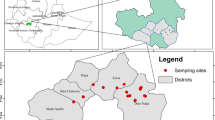Abstract
Total mercury concentration of typical wetland plants was analyzed in this paper. There were great differences of total mercury concentration among different plants: moss>hydrophyte>segde>herbage>shrub. Total mercury concentrations show an increasing trend from vascular plants to bryophytes, and from dry to wet lands. The mercury concentration of wetland plants was higher than that of crops. The wetland soil was the source of mercury in the air close to the ground, so it affected the concentration of mercury in the plant. In different parts of a plant, mercury concentration was in the order of: dead stand>root>leaf>stem. Mercury concentration increased at the initial stage and decreased in the end of the growing season. According to the mercury content and biomass, mercury stock of plants was 39.4µg/m2 above ground in Calamagrostis angustifolia wetland and 35.8µg/m2 and Carex lasiocarpa wetland.
Similar content being viewed by others
References
BISHOP K H, LEE Y H, MUNTHE J et al., 1998. Xylem sap as a pathway for total mercury and methylmecury transport from soils to tree canopy in the boreal forest [J]. Biogeochemistry, 40:102–113.
DRISCOLL C T, YAN C, SCHOFIELD C L et al., 1994. The mercury cycle and fish in the Adirondack lakes[J]. Environ. Sci. Technol., 28(3): 136A-143A.
DOBROVOLISKI V V (Translator: ZHU Yan-ming), 1987. Trace Elements Geography [M]. Beijing: Science Press, 153–154. (in Chinese)
HEYES A, MOORE T R, RUDD J W M, 1998. Mercury and methylmercury in decomposing vegetation of a pristine and impounded wetland [J]. Journal of Environmental Quality, 27(3):591–599.
IVERFELDT A, 1991. Mercury in forest canopy throughfall water and its relation to atmospheric deposition [J]. Water, Air and Soil Pollut., 56:553–564.
LIU Ru-hai, WANG Qi-chao, LU Xian-guo et al., The geochemistry characteristic of mercury in Sanjiang Plain Marsh[J]. Acta Sci. Circums., 22(5):661–663. (in Chinese)
LIU Xing-tu, MA Xue-hui, 2000. Influence of large-scale reclamation on natural environment and regional environmental protection in the Sanjiang Plain [J]. Scientia Geographica Sinica, 20(1):14–19. (in Chinese)
LODENIUS M, 1994. Mercury in terrestrial ecosystems: a review [A]. In: WATRAS C J, HUCKBEE T W (eds.). Mercury Pollution: Integration and Synthesis[C].Florida: Lewis Publ., 343–354.
MOORE T R, BUBIER J L, HEVES A et al., 1995. Methyl and total mercury in boreal wetland plants, experimental lakes area, northwestern Ontario [J]. Journal of Environmental Quality, 24(5): 845–850.
RASMUSSEN P E, MIERLE G, NRIAGU J O, 1991. The analysis of vegetation for total mercury[J]. Water, Air and Soil Pollut., 56:379–390.
RASMUSSEN P E, MIERLE P E, NRIAGU J O, 1994. ercury in vegetation of the Precambrian shied[A]. In: WATRAS C J, HUCKBEE T W (eds.). Mercury Pollution: Integration and Synthesis[C]. Florida: Lewis Publ., 417–425.
ST LOUIS V L, RUDD J W M, KELLY C A et al., 1994. Importance of wetlands as sources of methyl mercury boreal forest ecosystem[J]. Can. J. Fish. Aquat. Sci., 51:1065–1076.
SUNDLOF S F, SALDING M G, WENTWORTH J D et al., 1994. Mercury in livers of wading birds (Ciconiiformes) in southern Florida[J]. Arch. Environ. Contam. Toxicol., 27:299–305.
SWAIN E B, EEGATROM D R, BRIGHAM M E et al., 1992. Increasing rates of atmospheric mercury deposition in midcontinental North America[J]. Science, 257:784–787.
VEIGA M M, MEECH J A, ONTAE N, 1994. Mercury pollution from deforestation[J]. Nature, 368:816–817.
WALLSCHLAGER D, KOCK H H, SCHROEDER W H et al., 2000. Mechanism and significance of mercury volatilization from contaminated floodplains of the German river Elbe [J]. Atmospheric Environment, 34: 3745–3755.
YANG Yong-xing, WANG Shi-yan, HE Tai-rong et al., 2002. Study on plant biomass and its seasonal dynamics of typical wetland ecosystem in the Sanjiang Plain [J]. Grassland of China, 24(1): 1–7. (in Chinese)
ZILLIOUS E L, PORCELLA D B, BENOIT J M, 1993. Mercury cycling and effects in freshwater wetland ecosystems [J]. Environmental Toxicology and Chemistry, 12: 2245–2264.
Author information
Authors and Affiliations
Additional information
Foundation item: Supported by the National Natural Science Foundation of China (No. 40071072) and the Important Research Feild Project of Chinese Academy of Sciences (No. KZCX2-302)
Biography: LIU Ru-hai (1975–), male, a native of Tengzhou City of Shangdong Province, Ph. D., specialized in the pollutants’ behavior in environments and their control
Rights and permissions
About this article
Cite this article
Liu, Rh., Wang, Qc., Wang, Y. et al. Distribution of mercury in typical wetland plants in the Sanjiang plain. Chin. Geograph.Sc. 13, 242–246 (2003). https://doi.org/10.1007/s11769-003-0024-5
Received:
Issue Date:
DOI: https://doi.org/10.1007/s11769-003-0024-5




